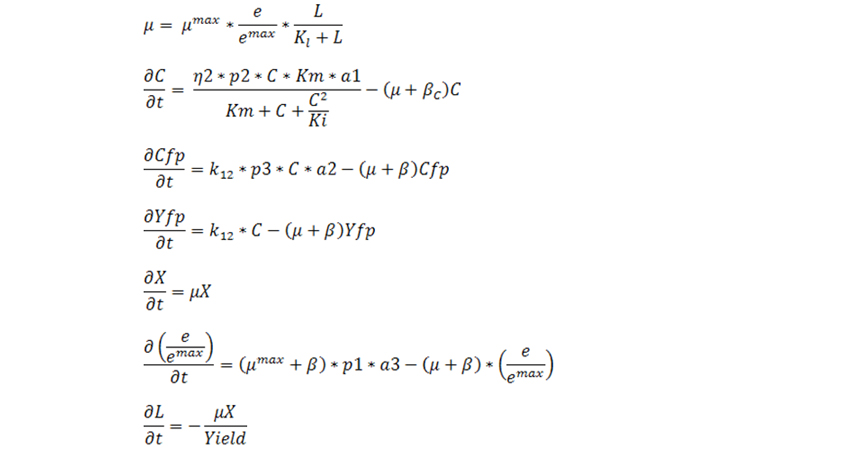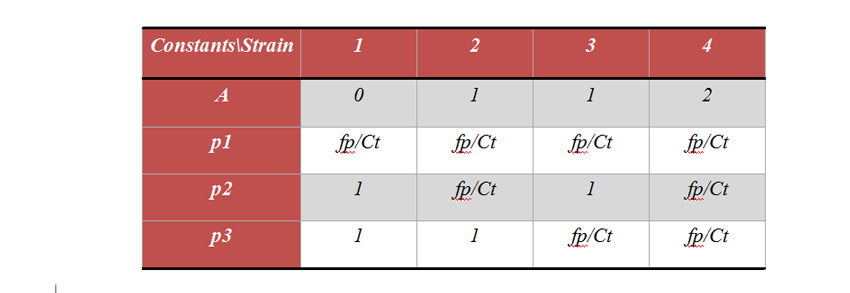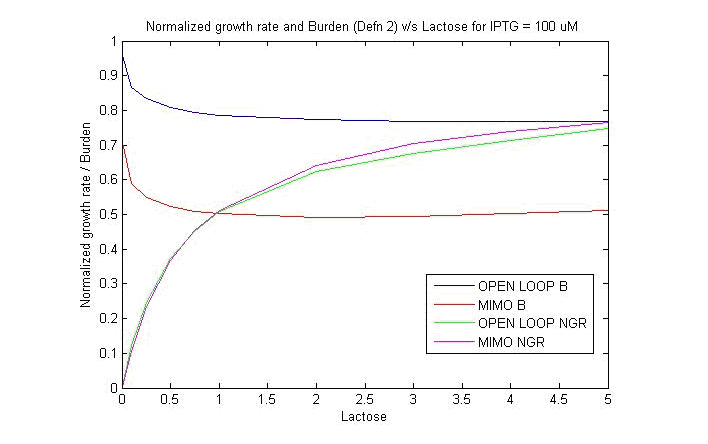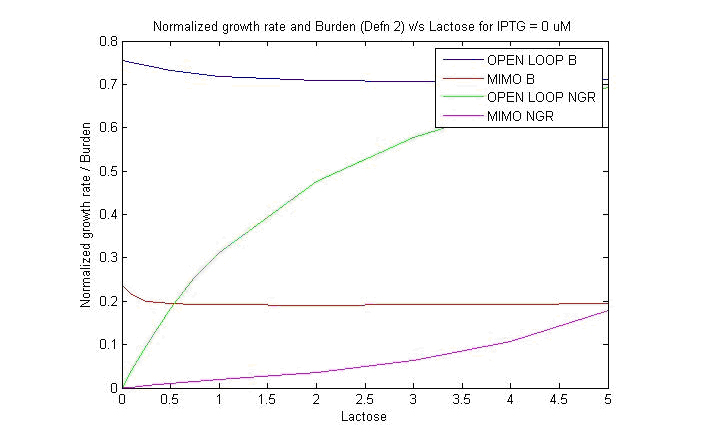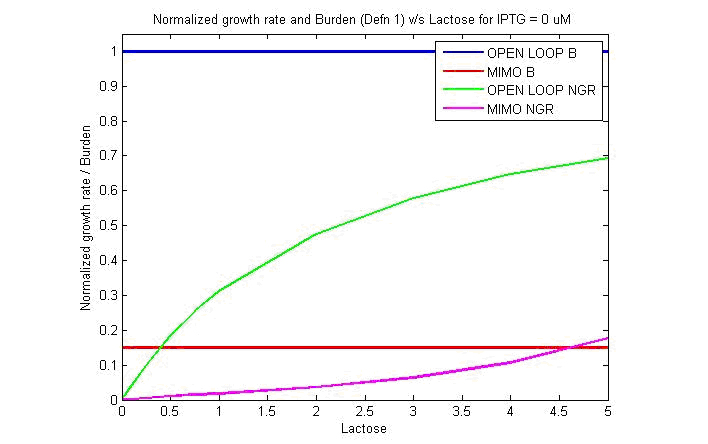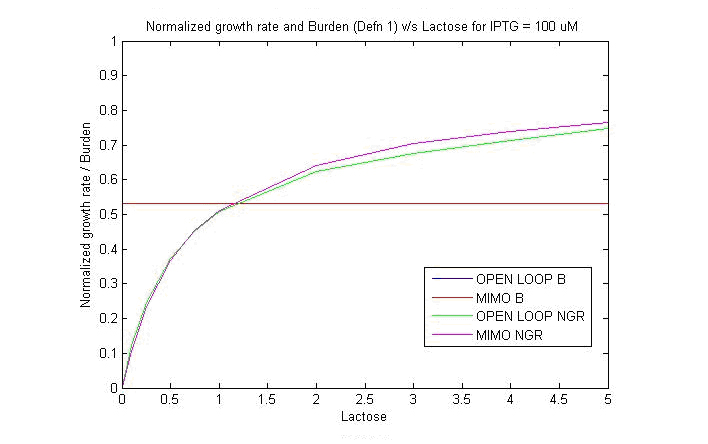Team:IIT Bombay India/DDM
From 2009.igem.org
Pranayiitb (Talk | contribs) |
Pranayiitb (Talk | contribs) |
||
| Line 29: | Line 29: | ||
'''Objective''' | '''Objective''' | ||
| - | Here we wish to show how the dynamics of the cellular material (proteins and plasmids) changes with time and IPTG and also how the specific growth rate of the four constructs on lactose is controlled and maximized by use of multiple feedbacks. In this model quantification by simulation was done and later results were verified by experimental data. | + | Here we wish to show how the dynamics of the cellular material (proteins and plasmids) changes with time and IPTG and also how the specific growth rate of the four constructs on lactose is controlled and maximized by use of multiple feedbacks. In this model quantification by simulation was done and later results were verified by experimental data. A concept of burden on cells and normalized growth rate is introduced to show that in multiple feedback loops helps in optimizing growth rate. |
| Line 77: | Line 77: | ||
'''Results''' | '''Results''' | ||
| - | + | We now define the cost that cell has to pay for growing in the Open loop and MIMO strains. In open loop, cell overproduces plasmid, LacI, Yfp and β-gal. | |
| + | In MIMO, it optimizes this load to as low as possible and is able to grow at higher specific growth rate. We define the burden on the cell by 2 different definitions: | ||
| + | Definition 1: | ||
| + | [[Image:pr5.jpg]] | ||
| + | |||
| + | Here all maximum values are the maximum amount of the protein or plasmid produced by mutant strain. Other definition used for Burden is | ||
| + | Definition 2 | ||
| - | + | [[Image:pr6.jpg]] | |
| + | |||
| + | The Normalized growth rate is | ||
| + | |||
| + | [[Image:pr7.jpg]] | ||
| + | |||
| + | Plots of Burden and Normalized growth rate at various Lactose show, that the strain 4 has been able to successfully reduce its burden and optimize its growth, whereas in strain 1 the overproduction occurs at the cost of reduced growth rate. At higher IPTG when MIMO strain behaves like Open loop it could be seen that burden on the cell increases. | ||
| + | For cells growth, cell has to produce the β-gal. In order to produce β-gal, our mutant strains have been forced to produce LacI and YFP protein. Due to this, cells now have only a part of machinery working for cell division. This is the burden that cells have to pay for growing at a particular specific growth rate. | ||
| + | |||
| + | |||
| + | [[Image:pr1.jpg]] | ||
| + | |||
| + | [[Image:pr2.jpg]] | ||
| + | |||
| + | [[Image:pr3.jpg]] | ||
| + | |||
| + | [[Image:pr4.jpg]] | ||
| + | |||
| + | '''Conclusions''' | ||
| + | |||
| + | |||
| + | 1. The detailed model was developed to generate the dynamic profiles of the plasmid copy number, LacI, Yfp, β-gal, Lactose and biomass. Using the above model, we are able to correlate the simulation results with the experimentally obtained values. | ||
| + | |||
| + | 2. We also see that growth on lactose for strain 4 is highest among the 4 strains with lesser burden on the cell to produce the unnecessarily higher amount of protein for growth. | ||
| + | |||
| + | 3. We observe that as lactose concentration is increased within our simulation range, burden of the cell does not change. For strain 4, as lactose concentration increases, the normalized growth rate crosses the burden, indicating that cell has now optimized its growth for the corresponding burden. For strain 1, the increase in lactose does not have any such effect and burden is always above the normalized growth rate. As IPTG increases, burden on strain 4 increases, the growth rate now crosses the burden at an higher value of lactose. Also as IPTG increases growth rate of strain 1 also increases. | ||
Revision as of 23:16, 21 October 2009
| Home | The Team | The Project | Analysis | Modeling | Notebook | Safety |
|---|
Detailed Deterministic Model |
|
Detailed Molecular Model Objective Here we wish to show how the dynamics of the cellular material (proteins and plasmids) changes with time and IPTG and also how the specific growth rate of the four constructs on lactose is controlled and maximized by use of multiple feedbacks. In this model quantification by simulation was done and later results were verified by experimental data. A concept of burden on cells and normalized growth rate is introduced to show that in multiple feedback loops helps in optimizing growth rate.
In our system we have the key components being plasmid copy number, fusion protein, yfp, lactose, IPTG and growth associated enzyme β-galactosidase. The E. coli genome inherently consists of β gal gene which has plac promoter. LacI interacts with lactose and IPTG and also with plac promoter. Assuming these 3 equilibrium reactions, we can now write differential equations for the components relating their concentrations with time. The total amount of plac promoter present in any strain could be given by the equation: Where ‘a’ is an integer which depends on the strain for which differential equation has been used to describe.(Total plac promoter, is the sum of concentration of free plac(fp) promoter and plac-LacI complex.
LacI total equals cfp (because they are a fusion protein). LacI refers to unbounded free lacI in the medium.
Note: here plac1, plac2, plac3 are the free plac associated with β-gal production, plasmid number and cfp-LacI protein. The differential equations are solved for two different conditions. Equations were first solved for 24 hours on other medium with different IPTG and no lactose. After 24 hours the equations were solved for the same value of IPTG but on different values of lactose. Equations for growth on no Lactose:
Equations for growth on Lactose:
We now define the cost that cell has to pay for growing in the Open loop and MIMO strains. In open loop, cell overproduces plasmid, LacI, Yfp and β-gal. In MIMO, it optimizes this load to as low as possible and is able to grow at higher specific growth rate. We define the burden on the cell by 2 different definitions: Definition 1: Here all maximum values are the maximum amount of the protein or plasmid produced by mutant strain. Other definition used for Burden is Definition 2 The Normalized growth rate is Plots of Burden and Normalized growth rate at various Lactose show, that the strain 4 has been able to successfully reduce its burden and optimize its growth, whereas in strain 1 the overproduction occurs at the cost of reduced growth rate. At higher IPTG when MIMO strain behaves like Open loop it could be seen that burden on the cell increases. For cells growth, cell has to produce the β-gal. In order to produce β-gal, our mutant strains have been forced to produce LacI and YFP protein. Due to this, cells now have only a part of machinery working for cell division. This is the burden that cells have to pay for growing at a particular specific growth rate. Conclusions
2. We also see that growth on lactose for strain 4 is highest among the 4 strains with lesser burden on the cell to produce the unnecessarily higher amount of protein for growth. 3. We observe that as lactose concentration is increased within our simulation range, burden of the cell does not change. For strain 4, as lactose concentration increases, the normalized growth rate crosses the burden, indicating that cell has now optimized its growth for the corresponding burden. For strain 1, the increase in lactose does not have any such effect and burden is always above the normalized growth rate. As IPTG increases, burden on strain 4 increases, the growth rate now crosses the burden at an higher value of lactose. Also as IPTG increases growth rate of strain 1 also increases.
|
 "
"




